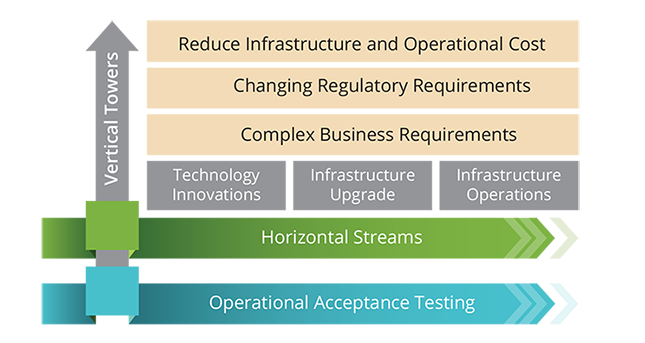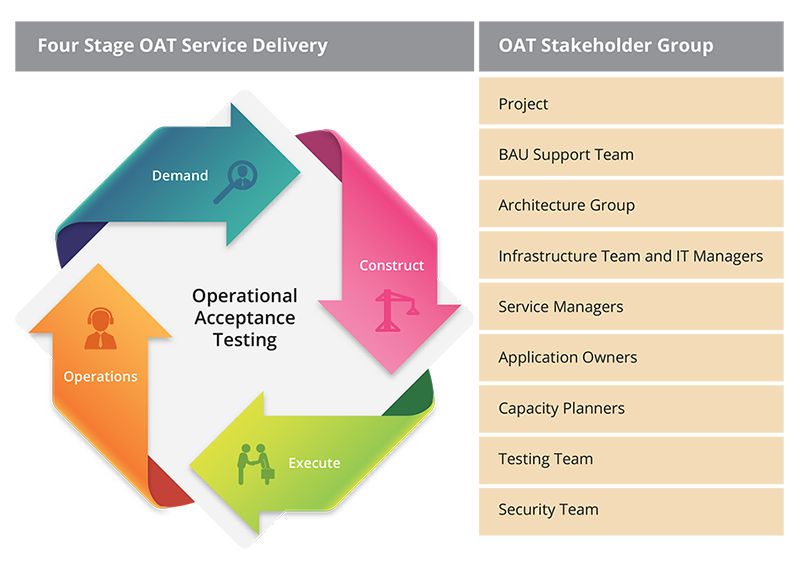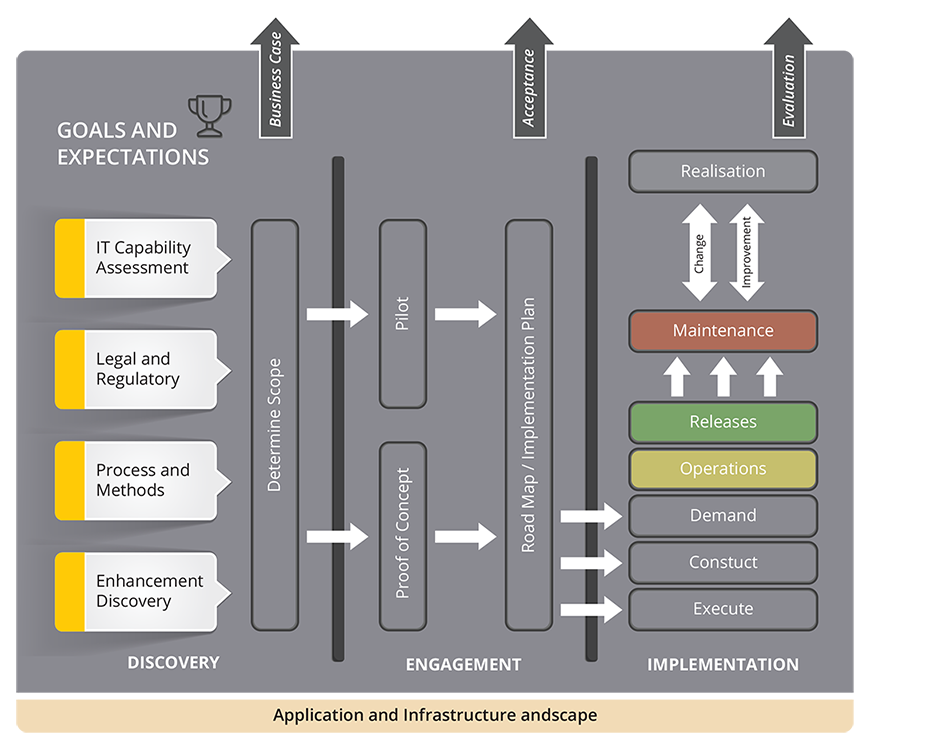With mounting pressure to build and release new business applications faster, organizations must leverage techniques that shrink the project lifecycle while ensuring quality. That is where Coforge’ Operational Acceptance Testing (OAT) Services can help.These services enable clients to realize more value from their software development efforts by shaping a robust test environment that improves efficiency, minimizes downtime, reduces infrastructure cost, and improves end-user experience.
The Complexity of Testing in a New Landscape
IT landscapes have become increasingly integrated and complex with cloud models such as infrastructure- and software-as-a-service, and infrastructure models such as virtualization and big data. Even as the IT landscape evolves, it is important for an organization to maintain enterprise business applications whilst maximizing the availability of business application services.
Increasing demand for integration of distributed systems and testing across shared services have added to the complexity of managing and completing projects, releases, change schedules, and business priorities. Along with these complexities, the feasibility of the test environment to ensure that all possible scenarios are tested is also critical for an organization.
Effectively coordinating releases, managing business priorities, and controlling change in shared services makes it a struggle for organizations to deliver reliable and stable services to the clients. In addition, cutting edge technology and innovation in business enterprise applications have significantly changed complex and service-oriented dependent services / interfaces that are distributed in nature and havea multi-tier architecture.
Landscape of IT Infrastructure

Get Ahead of Your Testing Challenges
Coforge’ Operational Acceptance Testing (OAT) services help clients improve their testing processes by unlocking new efficiencies across the test lifecycle, especially for business and IT managers, enabling them to start testing at an early stage in the process, at a lower cost, to ensure high quality of products.
As part of an OAT engagement, we study the complete system landscape, configuration and integration points before testing client systems and applications. This arms us with an understanding of dependencies, so we can control the impact of change on the client’s IT landscape.
OAT is a professional services-led approach that:
- Analyzes an organization’s current software testing needs and suggests improvements
- Proposes standards, processes, and guidelines to improve testing within the organization
- Helps clients implement right testing controls
- Offers pilot testing or proof of concept to understand the benefits and expected benefits
- Supports and trains clients throughout the process and even after the rollout
With multiple applications, complex infrastructure, and multiple interfaces, it is difficult for an organization to perform end-to-end testing. The configuration and system integration settings must be correct for an end-to-end scenario, otherwise the testing process suffers with organizations testing only a part of the system. Our OAT services address these key testing challenges in a number of ways. They:
- Improve operational efficiency by conducting infrastructure component-specific tests to reduce incidents and defect leakage, and ensure that post-production activities run smoothly with ready documentation
- Minimize unplanned downtime by testing configurations, resilience, and fault tolerance
- Ensure that legal, regulatory, and compliance requirements are met by conducting tests that address requirements such as service continuity and fulfillment of service-level agreements (SLAs) and operational-level agreements (OLAs)
- Improve client experience by conducting availability-, reliability- and maintainability-related tests to ensure that end users are satisfied with the service
- Minimize infrastructure cost by conducting tests and finding flaws in design, thereby reducing the cost to procure infrastructure and repair faulty components
- OAT implements fit-for-purpose environment-friendly techniques that are relevant to the phase and scope of testing. For example, in the OAT phase, appropriate environment, configuration and landscape integration is delivered to ensure that the testing is completed successfully.
How We Simplify OAT Management
Coforge offers three types of techniques / methodologies to deliver OAT testing:
- Testing: Our testing team is involved in determination of scope, test preparation, infrastructure teams performing witness testing, and closure reports production.
- Consulting: If the client has limited knowledge of OAT, we provide consultation right from initiation, planning and execution support, up to the completion of the project.
- Governance: If the client and the third-party teams have limited knowledge of OAT, our testing team provides governance in test execution, process and procedure support, and regulatory and compliance framework.
The delivery activities and the effort involved in OAT management vary depending on the type of service engagement. To tailor efforts to each requirement, we examine how the client’s testing processes can be optimized with the introduction of OAT for more cost-effective testing solutions.
OAT Services & Management

Our OAT Approach is Designed to Drive Quality
With our comprehensive approach to OAT, we not only help deliver effective OAT testing but also improve test processes. For example, we can plan and co-ordinate OAT, select tools, and train and create awareness among clients. Our team can also set up the OAT environment—a one-time activity to support the ongoing activities. This not only allows the client to perform continuous testing with each release but also offers them the opportunity to improve quality of product/services. This combination makes our OAT approach unique, with OAT-specific services that helps deliver OAT to ensure that the operational procedures are working as per the requirements. We can leverage existing or new client environments to perform OAT, offering clients the flexibility to choose an operational model that best suits their needs.
Leverage End-to-end Operational Acceptance Testing Services
Coforge uses a three-phase approach of discovery, engagement, and implementation / rollout.
Phase 1: Discovery
The goal of this phase is to identify the OAT requirements and opportunities that improve the client’s testing and operational processes.
A key service during this stage-IT service management capability assessment—provides customers relevant insights into the problems that need to be addressed, and the steps that need to be taken to solve them. The team analyzes the client’s current test methodology, process, and test environments, which include:
- Existing applications landscape and infrastructure
- Shared / reused environments
- Hardware configuration vetting and verification to best suit the business need, i.e., whether it fits the purpose and has appropriate sizing of hardware components
- Requirements of the test team
- Requirements of the project teams—administrators and SMEs
- Performance aspects such as response time, resource utilization, and capacity planning
In addition to the above, we also identify benefits from OAT service solution to implementation.
Phase 2: Engagement
In the second stage, we undertake the following:
- Project setup
- Detailed study of requirements
- Proof of concept
In cases where clients want a demonstration of the proposed OAT process, the required OAT pilot is provided to show that the process is workable and delivers expected results. This involves three stages:
- Define: The goals, environment, scope, coverage, and control measures are determined.
- Prepare: The OAT workspace on the client’s infrastructure is created, and the general test data requirements are determined and analyzed.
- Perform: OAT within the pilot environment is executed.
Phase 3: Implementation/Rollout
In the final stage of OAT service, we introduce end-to-end OAT rollout service in the client’s organization. Once the OAT process has been set up, it can be applied to the new software development or maintenance projects.
OAT service delivery or rollout is done in four phases:
- Demand: Our team gains an understanding of the OAT demand and determines the details of test-specific requirements such as test environments, scope of data sets, configuration, and integration.
- Construct: In this phase, new environments are built and existing environments are constructed within the client landscape. Artefacts such as code, packages, and configuration are managed for re-use, compliance, and audit purposes.
- Execute: After the environments have been provisioned, the test teams require support on many levels from the infrastructure team to carry out practical exercises or tests.
- Operations: In this phase, handover to the next project / release team is done for continued product delivery and integration. Handover to business-as-usual (BAU) support teams is done for ongoing product and solution maintenance.
To improve the test delivery and support process, our teams work to achieve alignment with the live production environment.
End-to-End Services for OAT

Delivering More Value
From discovery to implementation, our focus is on reducing effort, unlocking value levers, and accelerating go-live of your applications. Some of the key benefits of our Operational Acceptance Testing services include:
- Reduced operational expenditure by optimization of existing infrastructure
- Reduced cost of changes with continuous planning and implementation
- Faster implementation of changes by reducing the planning time, along with forward planning and capacity control
- Reduced risk of disruption, resulting in fewer mistakes and easier impact analysis
- Ease of maintaining accurate documentation
- Increased operational efficiency
- Ability to meet service-level agreements (SLAs) and operational-level agreements (OLAs)
- Assured delivery of reliable and stable systems
- Mature operational process and procedures
- Early detection of defects, enabling reduction in testing and infrastructure cost by 5-10%
- Improved client experience through minimal or no downtime
- Ability to meet regulatory and compliance requirements
- improved service quality and time-to-market
The Coforge Advantage
With testing experience from more than 1,000 successful projects for over 50 clients worldwide, we bring you industry-leading testing methodologies and valuable best practices to ensure successful project execution. We provide a range of proven automation testing frameworks (commercial and open source tools) that address the three critical dimensions of a project-time, cost, and quality.
Whether it is different usage scenarios or different functionalities, we offer a range of testing services to address varied needs across the full lifecycle of software projects. Add to this our dual-shore model for continuous capability improvement with capabilities in rapidly implementing test centers of excellence, and you are assured of faster turnaround times at a reduced cost of ownership.